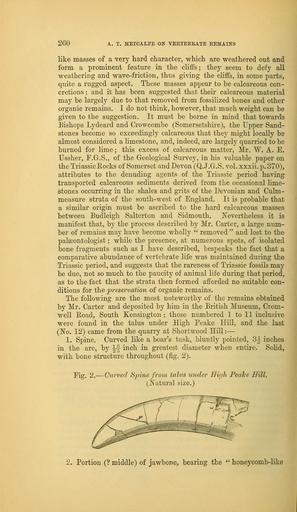MAKE A MEME
View Large Image

| View Original: | The_Quarterly_journal_of_the_Geological_Society_of_London_(14072637912).jpg (1204x2076) | |||
| Download: | Original | Medium | Small | Thumb |
| Courtesy of: | commons.wikimedia.org | More Like This | ||
| Keywords: The Quarterly journal of the Geological Society of London (14072637912).jpg 260 A T METCALFE ON YERTEBKATE EEMAESTS <br> like masses of a very hard character which are weathered out and <br> form a prominent feature in the cliiFs ; they seem to defy all <br> weathering and wave-friction thus giving the cliffs in some parts <br> quite a rugged aspect These masses appear to be calcareous con- <br> cretions ; and it has been suggested that their calcareous material <br> may be largely due to that removed from fossilized bones and other <br> organic remains I do not think however that much weight can be <br> given to the suggestion It must be borne in mind that towards <br> Bishops Lydeard and Crowcombe Somersetshire the Upper Sand- <br> stones become so exceedingly calcareous that the might locally be <br> almost considered a limestone and indeed are largely quarried to be <br> burned for lime ; this excess of calcareous matter Mr W A E <br> Ussher P G S of the Geological Survey in his valuable paper on <br> the TriassicE-ocks of Somerset and Devon Q J G S vol xxxii p 370 <br> attributes to the denuding agents of the Triassic period having <br> transported calcareous sediments derived from the occasional lime- <br> stones occurring in the shales and grits of the Devonian and Culm- <br> measure strata of the south-west of England It is probable that <br> a similar origin must be ascribed to the hard calcareous masses <br> between Budleigh Salterton and Sidmouth jSTevertheless it is <br> manifest that by the process described by Mr Carter a large num- <br> ber of remains may have become wholly removed and lost to the <br> palseontologist ; while the presence at numerous spots of isolated <br> bone fragments such as I have described bespeaks the fact that a <br> comparative abundance of vertebrate life was maintained during the <br> Triassic period and suggests that the rareness of Triassic fossils may <br> be due not so much to the paucity of animal life during that period <br> as to the fact that the strata then formed afforded no suitable con- <br> ditions for the preservation of organic remains <br> The following are the most noteworthy of the remains obtained <br> by Mr Carter and deposited by him in the British Museum Crom- <br> well Road South Kensington ; those numbered 1 to 11 inclusive <br> were found in the talus under High Peake Hill and the last <br> No 12 came from the quarry at Shortwood Hill ” <br> 1 Spine Curved like a boar's tusk bluntly pointed 3 inches <br> in the arc by inch in greatest diameter when entire Solid <br> with bone structure throughout fig 2 <br> Fig 2 ” Ciirvecl Spine from talus under Hic li Peahe Hill <br> Natural size <br> 2 Portion middle of jawbone bearing the honeycomb-like 36941049 113697 51125 Page 260 Text 40 http //www biodiversitylibrary org/page/36941049 1884 Geological Society of London Biodiversity Heritage Library The Quarterly journal of the Geological Society of London v 40 1884 Geology Periodicals Smithsonian Libraries bhl page 36941049 dc identifier http //biodiversitylibrary org/page/36941049 smithsonian libraries Information field Flickr posted date ISOdate 2014-04-30 Check categories 2015 August 26 CC-BY-2 0 BioDivLibrary https //flickr com/photos/61021753 N02/14072637912 2015-08-26 05 56 05 cc-by-2 0 PD-old-70-1923 The Quarterly journal of the Geological Society of London 1884 Photos uploaded from Flickr by Fæ using a script | ||||